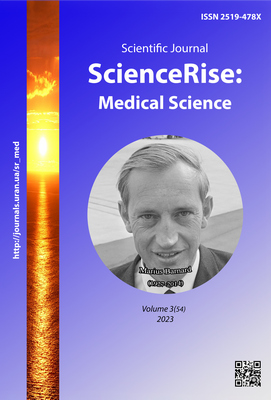Surgical treatment of elderly and senile patients with transtrochanteric fractures of the femur
DOI:
https://doi.org/10.15587/2519-4798.2023.285690Keywords:
transtrochanteric fracture, osteosynthesis, elderly and senile patientsAbstract
+
The aim of the work was to analyze the functional results of surgical treatment in elderly and senile patients with transcavitary fractures depending on the method of osteosynthesis.
Materials and methods. 134 elderly and senile patients with transtrochanteric fractures of the femur type 31A1.1-A1.3 according to AO/ASIF were examined (average age - 72.4±9.3 years). The patient underwent osteosynthesis with a DHS fixator, a PFNA rod and a Gamma nail according to indications. The functional result of the treatment was determined by radiographic signs of fusion, the Harris scale, and complications detected during the period of 1, 3, 6, and 12 months of examination.
Results and their discussion. The functional result according to the Harris scale dramatically prevailed in the first six months after surgical treatment with intramedullary osteosynthesis. For the DHS fixator, the indicator improved from 29.8 points in the first month to 57.7 at the sixth month, for the PFNA rod - from 50.7 points to 76.9, and for the Gamma nail from 50.1 to 76.7, respectively.
Consolidation of a transtrochanteric fracture in treated elderly and senile patients was observed in 83.33 % of cases after extramedullary osteosynthesis, and in 90.22 % of cases after intramedullary osteosynthesis. Complications of extramedullary osteosynthesis included instability of the fixator with migration and fracture of the fixator, during intramedullary osteosynthesis – migration of the cervical blade "cut-out" and fracture of the rod.
Conclusions. The functional result in elderly and senile patients with transtrochanteric fractures after intramedullary osteosynthesis has advantages over extramedullary osteosynthesis. The results of the calculation of the Harris scale indicators, among which the evaluation of the restoration of gait, movements and resistance of the injured limb were decisive, are significantly higher in osteosynthesis with a Gamma nail and a PFNA rod in comparison with a DHS fixator. Complications that occurred in the three groups of the study coincide with the average international indicators and are not significantly low with intramedullary osteosynthesis. Improvement of surgical treatment methods is urgent and requires the search for complex treatment approaches in elderly and senile patients with transtrochanteric fractures
References
- Grygorieva, N. V., Zubach, O. B. (2022). Risk factors of proximal hip fractures in older patients. TRAUMA, 17 (6), 53–61. doi: https://doi.org/10.22141/1608-1706.6.17.2016.88618
- Malyk, V. D. (2017). Structure and principles of factors treatment of fractures of the proximal femur (literature review) Visnyk Vinnytskoho natsionalnoho medychnoho universytetu, 21 (1 (2)), 350–356.
- Kaiafa, A. M., Zhuk, O. M., Demchuk, R. M. (2016). Treatment of hip fracture in trochanteric area: modern state of the problem (literature review). Visnyk morfolohii, 2 (1), 186–191.
- Povoroznyuk, V. V., Grygorieva, N. V., Korzh, M. O., Strafun, S. S., Vaida, V. M., Klymovytsky, F. V. et al. (2022). Epidemiology of the proximal femur fractures in ukraine: results of stop-study (system of registration of osteoporotic fractures in ukrainian population). TRAUMA, 17 (5), 14–20. doi: https://doi.org/10.22141/1608-1706.5.17.2016.83870
- Kalchenko, A. V., Babalian, V. A., Hurbanova, T. S., Mazniakov, S. M. (2016). Surgical treatment of proximal femur osteoporotic fractures (literature review)). Ortopedyia, travmatolohyia y protezyrovanye, 2, 111–119.
- Tian, Z., Chen, J., Zhang, Y., Shi, L., Li, W. (2022). A Retrospective Study of 98 Elderly Patients with High-Risk Lateral Femoral Wall Intertrochanteric Hip Fractures to Compare Outcomes Following Surgery with Proximal Femoral Nail Antirotation (PFNA) Versus Dynamic Hip Screw (DHS). Medical Science Monitor, 28. doi: https://doi.org/10.12659/msm.936923
- van der Sijp, M. P. L., de Groot, M., Meylaerts, S. A., du Pré, K. J., Verhage, S. M., Schipper, I. B., Niggebrugge, A. H. P. (2021). High risks of failure observed for A1 trochanteric femoral fractures treated with a DHS compared to the PFNA in a prospective observational cohort study. Archives of Orthopaedic and Trauma Surgery, 142 (7), 1459–1467. doi: https://doi.org/10.1007/s00402-021-03824-0
- Guo, Y., Yang, H. P., Dou, Q. J., He, X. B., Yang, X. F. (2017). Efficacy of femoral nail anti-rotation of helical blade in unstable intertrochanteric fracture. European Review for Medical and Pharmacological Sciences, 21 (3), 6–11.
- Huang, S.-G., Chen, B., Zhang, Y., Nie, F.-F., Ju, L., Li, M., Zhang, Y.-H. (2017). Comparison of the Clinical Effectiveness of PFNA, PFLCP, and DHS in Treatment of Unstable Intertrochanteric Femoral Fracture. American Journal of Therapeutics, 24 (6), e659–e666. doi: https://doi.org/10.1097/mjt.0000000000000346
- Singh, N. K., Sharma, V., Trikha, V., Gamanagatti, S., Roy, A., Balawat, A. S. et al. (2019). Is PFNA-II a better implant for stable intertrochanteric fractures in elderly population ? A prospective randomized study. Journal of Clinical Orthopaedics and Trauma, 10, S71–S76. doi: https://doi.org/10.1016/j.jcot.2019.02.004
Downloads
Published
How to Cite
Issue
Section
License
Copyright (c) 2023 Yurii Valovina, Andriy Golynskyy, Nelia Valovina, Zorian Halii, Stepan Smachylo, Nazar Smahlii

This work is licensed under a Creative Commons Attribution 4.0 International License.
Our journal abides by the Creative Commons CC BY copyright rights and permissions for open access journals.
Authors, who are published in this journal, agree to the following conditions:
1. The authors reserve the right to authorship of the work and pass the first publication right of this work to the journal under the terms of a Creative Commons CC BY, which allows others to freely distribute the published research with the obligatory reference to the authors of the original work and the first publication of the work in this journal.
2. The authors have the right to conclude separate supplement agreements that relate to non-exclusive work distribution in the form in which it has been published by the journal (for example, to upload the work to the online storage of the journal or publish it as part of a monograph), provided that the reference to the first publication of the work in this journal is included.









